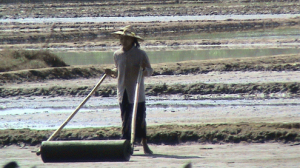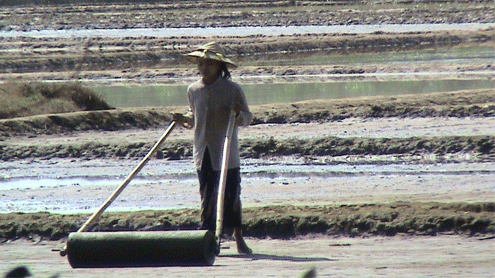Rai Maraoh – Due to unusually heavy rain during Southeast Asia’s summer season, salt production in Mon State has come to a stop after salt fields were destroyed by the excess water, causing financial difficulties for salt producers.

Uncommon rainfall hit Mon State on December 3, 2010, January 11, 2011, and March 14, 2011. According to Nai Tin Aung, a salt field owner, most of the salt fields in Mon State were destroyed because of the heavy rain.
Before the rainfall, the price of salt was sold for 40 kyat per viss [1.6 kg is equal to 1 viss], but the price of salt increased to 100 kyat per viss by the second week of March. Though prices for salt did not fluctuate, salt owners lost money because they were not able to collect their salt.
“I’m sure I lost about 10 million kyat. My salt field is near the village and I lost my money, but for the [salt field] owners whose fields are far from the village, they will lose more than me,” said Nai Thin Aung, who owns 30 acres of salt in Panga village, Thanphyuzayart Township, Mon State.
Nai Tin Aung said that he invested 20 million kyat for the 30 acres of salt field that he has, and he has only made four million kyat back. He explained that if the weather had been good when he was doing salt production, he would have collected 500,000 viss, but this year it will be difficult to collect even 200,000 viss.
“This didn’t happen to only me. Every single salt field owner is having problems, we will not be able to start salt production again because it is still raining,” Nai Tin Aung said.
Salt field owners begin salt cultivation at the beginning of September and are normally able to produce by January. Normally, they would stop cultivation by May, at the beginning of the rainy season, but this year salt cultivators stopped at the beginning of April.
“The small salt field owners have already stopped [collection], while some of the other owners are wrapping up their production,” explained Nai Win, a salt trader from Panga Village.
Nai Win estimated that every salt field owner lost money this year, some losing half of their profit, and others losing two thirds.
Thanphyuzayart Township produces the most salt in Mon State, while Ye Township, Poung Township and Tadon Township also produce salt.Mon State produces 10 percent of the salt in Burma.

